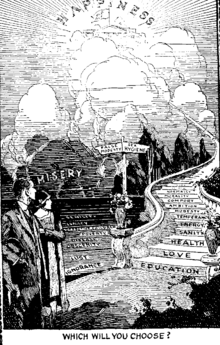Social hygiene movement

The social hygiene movement of the late 19th and early 20th centuries was an attempt by Progressive-era reformers to control venereal disease, regulate prostitution and vice, and disseminate sexual education through the use of scientific research methods and modern media techniques. A mental hygiene movement also developed, partly separately and now generally known as mental health, although the older term is still in use, e.g. in New York state's law.[1]
The social hygiene movement represented a rationalized, professionalized version of the earlier social purity movement.[2] Many reformers, such as Marie Stopes, were also proponents of eugenics. Inspired by Charles Darwin's theory of natural selection, they argued for the sterilisation of certain groups, even racial groups, in society. Indeed by the 1930s thousands of forced sterilizations of people deemed undesirable took place in America and other countries each year. This continued for several more decades in some countries, though after 1945, the movement was largely discredited.[3]
This link between racial hygiene and social hygiene movements can be seen in Australia, where the Racial Hygiene Association of New South Wales is now named The Family Planning Association.[4]
Social hygiene as a profession grew alongside social work and other public health movements of the era. Social hygienists emphasized sexual continence and strict self-discipline as a solution to societal ills, tracing prostitution, drug use and illegitimacy to rapid urbanization.
The American Social Hygiene Association was formed in 1913. It was later renamed to the American Social Health Association and, in 2012, the American Sexual Health Association.
The movement remained alive throughout much of the 20th century and found its way into American schools, where it was transmitted in the form of classroom films about menstruation, sexually transmitted disease, drug abuse and acceptable sexual behavior in addition to an array of pamphlets, posters, textbooks and films.[5]
See also
- Comstock laws
- History of condoms
- Mann Act
- Mental health
- Racial hygiene
- Timeline of reproductive rights legislation
References
- ↑ NYS Mental Hygiene Admissions Process
- ↑ Simmons, Christina (July 1993). "African Americans and Sexual Victorianism in the Social Hygiene Movement, 1910-40". Journal of the History of Sexuality 4 (1): 51–75. JSTOR 3704179.
- ↑ Encyclopedia of Children and Childhood in History and Society: Hygiene JACQUELINE S. WILKIE.
- ↑ Family Planning NSW: News: Announcements: 80 years of Family Planning
- ↑ Tupper, Kenneth (2013). "Sex, Drugs and the Honour Roll: The Perennial Challenges of Addressing Moral Purity Issues in Schools". Critical Public Health 24 (2): 115–131. doi:10.1080/09581596.2013.862517.
External links
- American Social Hygiene Posters - Online repository of social hygiene posters from the University of Minnesota
- The Prelinger Archives at the Internet Archive
- AV Geeks at the Internet Archive
| ||||||||||||||||||||||||||||||||||||||||||